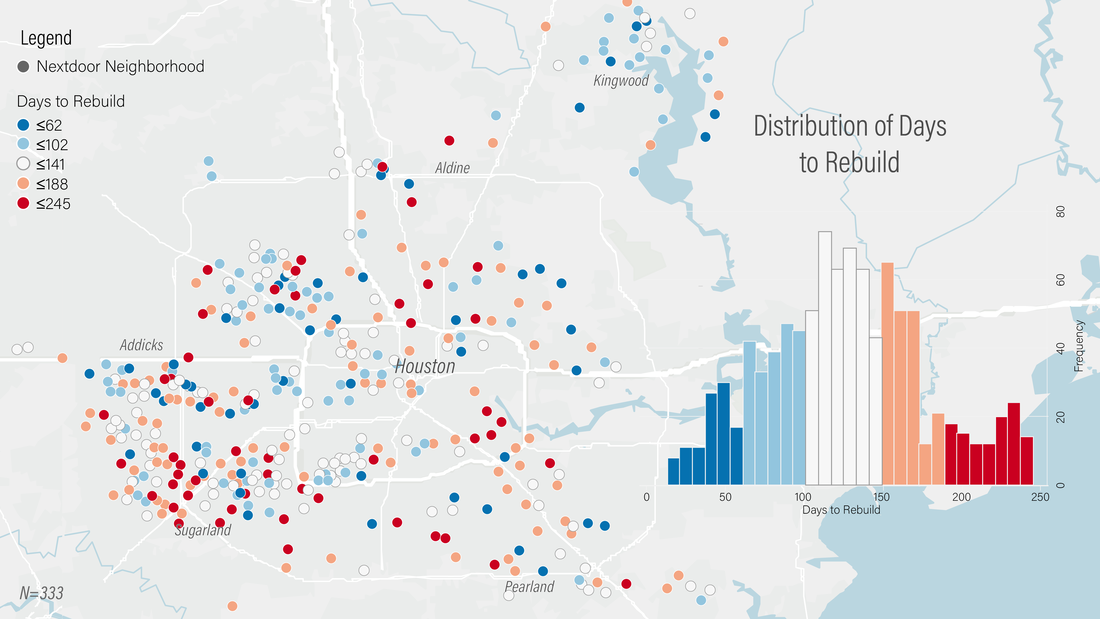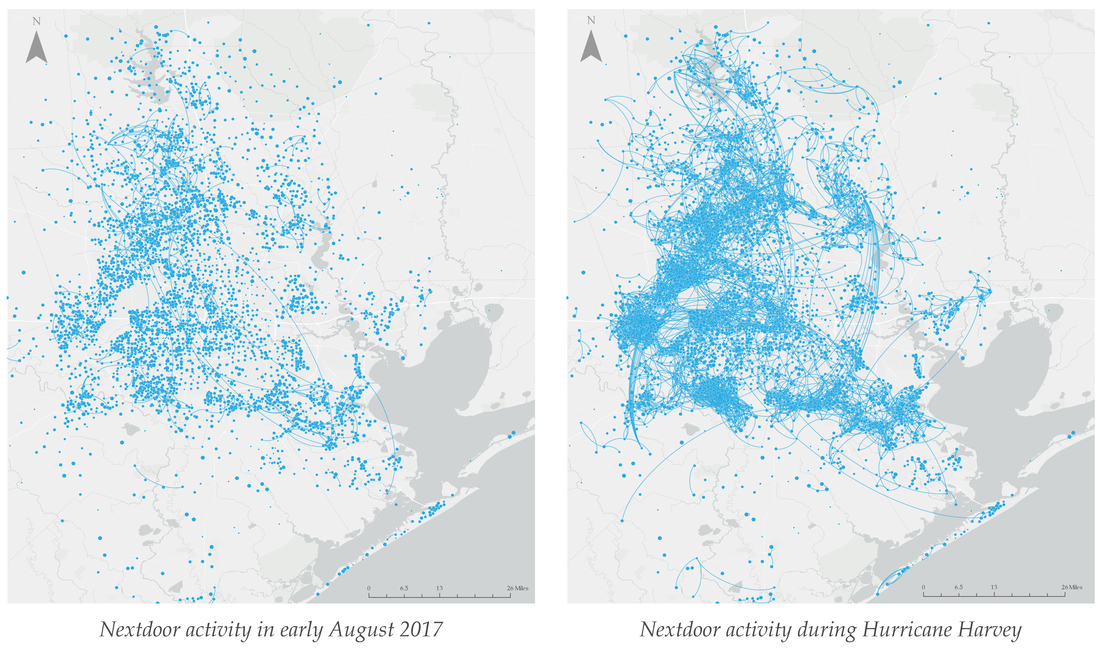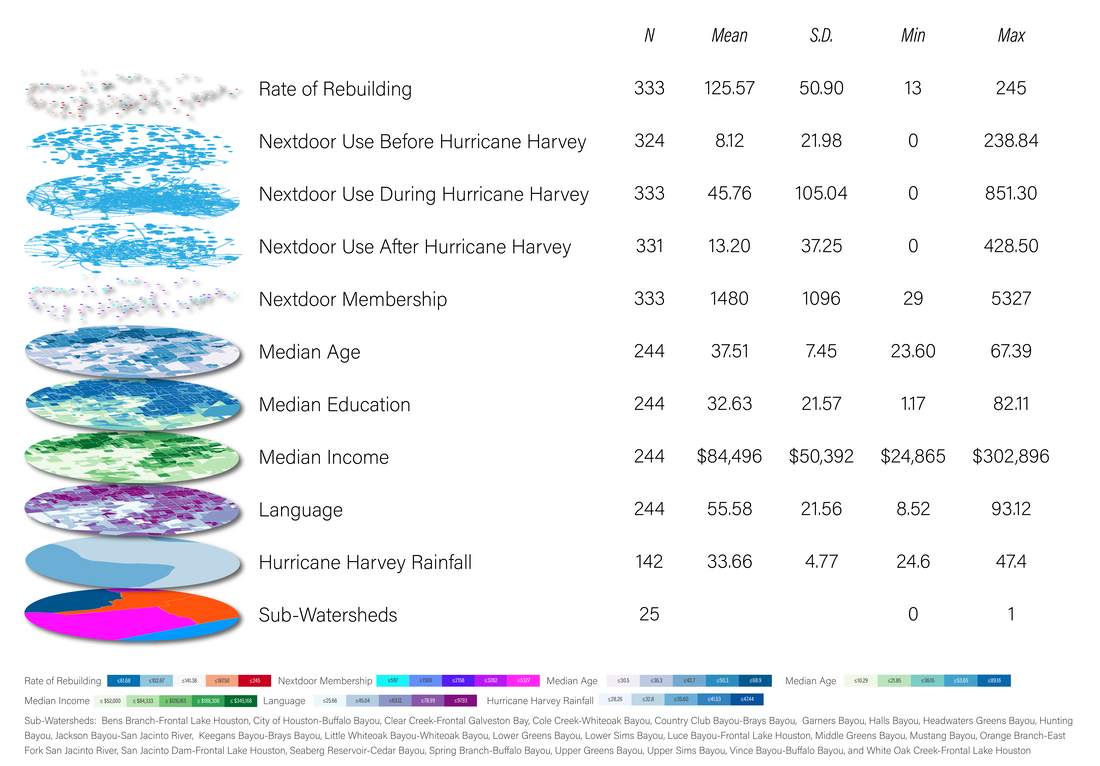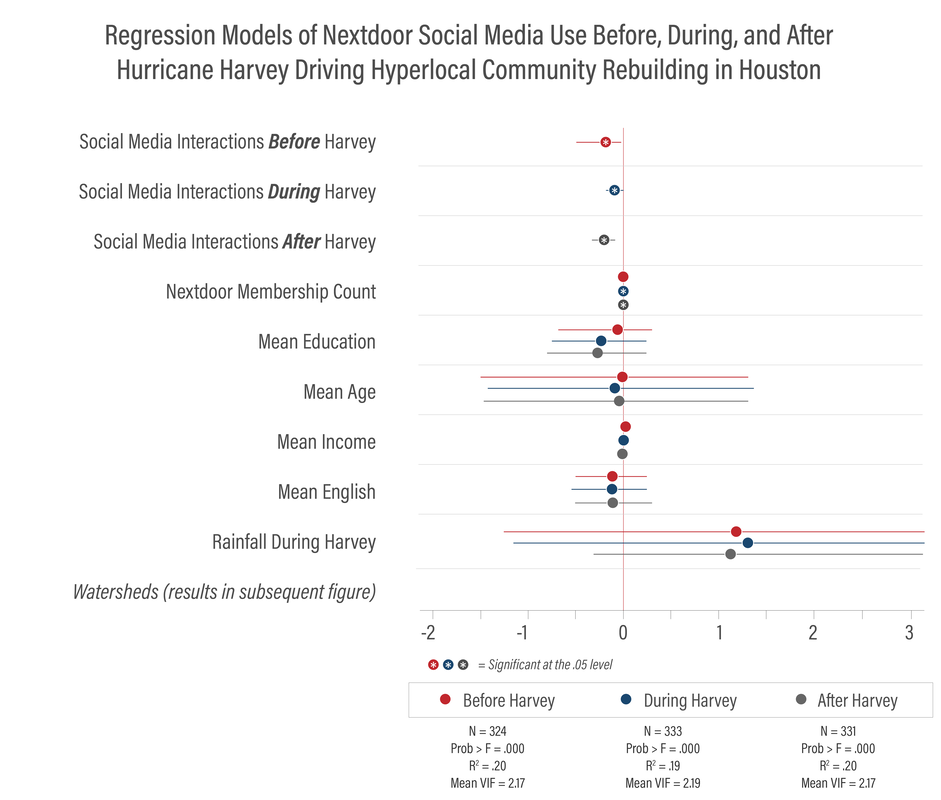- Covid-19 to go? The role of disasters and evacuation in the Covid-19 pandemic (Global Environmental Change: Human and Policy Dimensions)
- An analysis of social media use and neighbor-assisted debris removal in Houston following Hurricane Harvey (International Journal of Disaster Risk Reduction)
- Bonding, bridging, and linking social capital and social media use: How hyperlocal social media platforms serve as a conduit to access and activate bridging and linking ties in a time of crisis (Natural Hazards)
- The role of social media in disaster recovery following Hurricane Harvey (Journal of Homeland Security and Emergency Management)
- The power of social media: How online connections expedited public services following Hurricane Harvey (Natural Hazards Center Quick Response Grant Report Series)
COVID-19 TO GO?
THE ROLE OF DISASTERS AND EVACUATION IN THE COVID-19 PANDEMIC
Abstract
Since the start of the pandemic, some U.S. communities have faced record storms, fires, and floods. Communities have confronted the increased challenge of curbing the spread of COVID-19 amid evacuation orders and short-term displacement that result from hazards. This raises the question of whether disasters, evacuations, and displacements have resulted in above-average infection rates during the COVID-19 pandemic. This study investigates the relationship between disaster intensity, sheltering-in-place, evacuation-related mobility, and contagion following Hurricane Zeta in Southeastern Louisiana and The Wildfires in Napa and Sonoma Counties, California, known as the Glass Fire. We draw on data from the county subdivision level and mapped and aggregated tallies of Facebook user movement from the Facebook Data for Good program’s GeoInsights Portal. We test the effects of disasters, evacuation, and shelter-in-place behaviors on COVID-19 spread using panel data models, matched panel models, and synthetic control experiments. Our findings suggest associations between disaster intensity and higher rates of COVID-19 cases. We also find that while sheltering-in-place led to decreases in the spread of COVID-19, evacuation-related mobility did not result in our hypothesized surge of cases immediately after the disasters. The findings from this study aim to inform policymakers and scholars about how to better respond to disasters during multi-crisis events, such as offering hotel accommodations to evacuees instead of mass shelters and updating intake and accommodation procedures at shelters, such as administration temperature screenings, offering hand sanitizing stations, and providing isolated areas for ill evacuees.
Since the start of the pandemic, some U.S. communities have faced record storms, fires, and floods. Communities have confronted the increased challenge of curbing the spread of COVID-19 amid evacuation orders and short-term displacement that result from hazards. This raises the question of whether disasters, evacuations, and displacements have resulted in above-average infection rates during the COVID-19 pandemic. This study investigates the relationship between disaster intensity, sheltering-in-place, evacuation-related mobility, and contagion following Hurricane Zeta in Southeastern Louisiana and The Wildfires in Napa and Sonoma Counties, California, known as the Glass Fire. We draw on data from the county subdivision level and mapped and aggregated tallies of Facebook user movement from the Facebook Data for Good program’s GeoInsights Portal. We test the effects of disasters, evacuation, and shelter-in-place behaviors on COVID-19 spread using panel data models, matched panel models, and synthetic control experiments. Our findings suggest associations between disaster intensity and higher rates of COVID-19 cases. We also find that while sheltering-in-place led to decreases in the spread of COVID-19, evacuation-related mobility did not result in our hypothesized surge of cases immediately after the disasters. The findings from this study aim to inform policymakers and scholars about how to better respond to disasters during multi-crisis events, such as offering hotel accommodations to evacuees instead of mass shelters and updating intake and accommodation procedures at shelters, such as administration temperature screenings, offering hand sanitizing stations, and providing isolated areas for ill evacuees.
Citation: Page-Tan, C. and Fraser, T. (2022) Covid-19 to go? The role of disasters and evacuation in the Covid-19 pandemic. Global Environmental Change: Human and Policy Dimensions. https://doi.org/10.1016/j.gloenvcha.2022.102471
AN ANALYSIS OF SOCIAL MEDIA USE AND NEIGHBOR-ASSISTED DEBRIS REMOVAL IN HOUSTON FOLLOWING HURRICANE HARVEY
Abstract
Hurricane Harvey was social media's first real stress test. Despite headlines that praise platforms like Facebook, Twitter, and Nextdoor for their role in disasters, we still know little about how community resilience differs across these platforms in a single event across a single measure of recovery. With an original dataset from a survey administered in Houston 39 days following Hurricane Harvey, this study explores the community resilience outcomes across users of Facebook, Twitter, and Nextdoor; more specifically, if users agreed that their neighbors engaged in neighborhood-level coordinated recovery efforts in the weeks following the storm. Controlling for collective efficacy, storm impact, amount of aid received, age, gender, income, education attainment, home tenure, and survey modality, findings from two multinomial logistic regression analyses reveal that individuals who used Nextdoor were more likely to receive help from neighbors to collect and pile debris following Hurricane Harvey compared to individuals who indicated they never used the platform, a finding not found among Facebook and Twitter users. This study identifies important differences in the resilience outcomes across these three platforms and discusses implications for future research and resilience policies.
Hurricane Harvey was social media's first real stress test. Despite headlines that praise platforms like Facebook, Twitter, and Nextdoor for their role in disasters, we still know little about how community resilience differs across these platforms in a single event across a single measure of recovery. With an original dataset from a survey administered in Houston 39 days following Hurricane Harvey, this study explores the community resilience outcomes across users of Facebook, Twitter, and Nextdoor; more specifically, if users agreed that their neighbors engaged in neighborhood-level coordinated recovery efforts in the weeks following the storm. Controlling for collective efficacy, storm impact, amount of aid received, age, gender, income, education attainment, home tenure, and survey modality, findings from two multinomial logistic regression analyses reveal that individuals who used Nextdoor were more likely to receive help from neighbors to collect and pile debris following Hurricane Harvey compared to individuals who indicated they never used the platform, a finding not found among Facebook and Twitter users. This study identifies important differences in the resilience outcomes across these three platforms and discusses implications for future research and resilience policies.
Citation: Page-Tan, C. (2021). An analysis of social media use and neighbor-assisted debris removal in Houston following Hurricane Harvey. International Journal of Disaster Risk Reduction. https://doi.org/10.1016/j.ijdrr.2021.102450
Bonding, bridging, and linking social capital and social media use:
How hyperlocal social media platforms serve as a conduit to access and activate bridging and linking ties in a time of crisis
Abstract
Social media is changing the narrative during crisis events. It has facilitated citizen-led emergency dispatch and rescue, information sharing and communication between loved ones in the moments before, during and after a disaster. Researchers of social capital have found that bonding, bridging, and linking social capital can lead to resilient outcomes. With increased use of social media on a day-to-day basis and during a crisis, we still know little about the association between social capital and online social media use. Controlling for demographic characteristics and earthquake intensity, I investigate the association bonding, bridging and linking social capital and hyperlocal social media use following the earthquake and its aftershocks. Using a quantitative cross-sectional longitudinal study across 121 Nextdoor online neighborhoods in California’s Napa Valley region across 42 days in August and September of 2014 (N = 3570), I find that bridging and linking social capital led to more online communication via Nextdoor. This finding comes with an important implication, namely, that social media can serve as a primary source of recourse for individuals and communities following a disaster. Social media platforms provide a conduit for accessing and activating bridging and linking ties that can expedite collective action in a time of need. Communities should consider policies that increase levels of social capital, well as social media platforms that can activate social ties when they are needed most.
Social media is changing the narrative during crisis events. It has facilitated citizen-led emergency dispatch and rescue, information sharing and communication between loved ones in the moments before, during and after a disaster. Researchers of social capital have found that bonding, bridging, and linking social capital can lead to resilient outcomes. With increased use of social media on a day-to-day basis and during a crisis, we still know little about the association between social capital and online social media use. Controlling for demographic characteristics and earthquake intensity, I investigate the association bonding, bridging and linking social capital and hyperlocal social media use following the earthquake and its aftershocks. Using a quantitative cross-sectional longitudinal study across 121 Nextdoor online neighborhoods in California’s Napa Valley region across 42 days in August and September of 2014 (N = 3570), I find that bridging and linking social capital led to more online communication via Nextdoor. This finding comes with an important implication, namely, that social media can serve as a primary source of recourse for individuals and communities following a disaster. Social media platforms provide a conduit for accessing and activating bridging and linking ties that can expedite collective action in a time of need. Communities should consider policies that increase levels of social capital, well as social media platforms that can activate social ties when they are needed most.
Citation: Page-Tan, C. (2021). Bonding, bridging, and linking social capital and social media use: How hyperlocal social media platforms serve as a conduit to access and activate bridging and linking ties in a time of crisis. Natural Hazards, 1-22. https://doi.org/10.1007/s11069-020-04397-8
THE ROLE OF SOCIAL MEDIA IN DISASTER RECOVERY FOLLOWING HURRICANE HARVEY
Abstract
Hurricane Harvey was social media's first real stress test as a disaster response and recovery mechanism. A confluence of conditions makes it an ideal case study of social media's role in disaster recovery: the lack of a government-issued evacuation order, a call from government leadership for willing and able volunteers with a boat or high-water vehicle to perform life-saving rescues, and wide-spread adoption of social media platforms in the Houston area. While research on online social networks and disasters continues to grow, social scientists know little about how these online networks transform during a crisis and, further, how they drive disaster outcomes. With two original datasets, this study investigates how Houston's online social network transformed during Hurricane Harvey (2017), and the relationship between social media activity and post-Harvey recovery. The findings of a social network analysis (N= 2,387,610) and subsequent statistical analyses reveal the Houston-area online social network grew denser, clustered, and more efficient during the disaster. A spatial analysis and three separate regression models of activity before, during, and after Hurricane Harvey reveal that among 333 Nextdoor Neighborhoods, hyperlocal social media activity was a statistically significant predictor of the rate of rebuilding in these geographically based online communities. These findings suggest that policy and decision-makers should invest into online and offline hyperlocal social networks well before a disaster strikes, and leverage resources and legislation to maintain and strengthen the telecommunications and energy infrastructure that supports access to social media and telecommunications infrastructure during a time of crisis.
Hurricane Harvey was social media's first real stress test as a disaster response and recovery mechanism. A confluence of conditions makes it an ideal case study of social media's role in disaster recovery: the lack of a government-issued evacuation order, a call from government leadership for willing and able volunteers with a boat or high-water vehicle to perform life-saving rescues, and wide-spread adoption of social media platforms in the Houston area. While research on online social networks and disasters continues to grow, social scientists know little about how these online networks transform during a crisis and, further, how they drive disaster outcomes. With two original datasets, this study investigates how Houston's online social network transformed during Hurricane Harvey (2017), and the relationship between social media activity and post-Harvey recovery. The findings of a social network analysis (N= 2,387,610) and subsequent statistical analyses reveal the Houston-area online social network grew denser, clustered, and more efficient during the disaster. A spatial analysis and three separate regression models of activity before, during, and after Hurricane Harvey reveal that among 333 Nextdoor Neighborhoods, hyperlocal social media activity was a statistically significant predictor of the rate of rebuilding in these geographically based online communities. These findings suggest that policy and decision-makers should invest into online and offline hyperlocal social networks well before a disaster strikes, and leverage resources and legislation to maintain and strengthen the telecommunications and energy infrastructure that supports access to social media and telecommunications infrastructure during a time of crisis.
Citation: Page-Tan, C. (2020). The Role of Social Media in Disaster Recovery Following Hurricane Harvey. Journal of Homeland Security and Emergency Management, 18(1), 93-123. https://doi.org/10.1515/jhsem-2018-0054
THE POWER OF SOCIAL MEDIA:
HOW ONLINE CONNECTIONS EXPEDITED PUBLIC SERVICES FOLLOWING HURRICANE HARVEY
Abstract
Disasters and crises place often insurmountable demands on the emergency response apparatus of local, state, and federal authorities. In late August 2017, Hurricane Harvey descended upon Houston, a metropolis of 2.3 million people, and hovered over the city for days. As floodwaters continued to rise, so did the number of 911 calls for rescue, overwhelming Houston’s emergency response services, and forcing many to rely on their offline and online networks to seek help during and after the hurricane. This paper investigates the effect of community-level social capital on fatalities and debris removal, and the impact of social media on the governing infrastructure during Hurricane Harvey. Using geo-data on fatalities, levels of social capital, and debris removal, along with interviews, the author finds that: fatality rates were, in fact, lower in communities with higher levels of social capital; debris removal was expedited across communities with higher levels of social capital; and social media played a Janus-faced role during Hurricane Harvey—placing a heavy strain on government infrastructure—but also aiding agencies in conveying critical information in a time of need.
Disasters and crises place often insurmountable demands on the emergency response apparatus of local, state, and federal authorities. In late August 2017, Hurricane Harvey descended upon Houston, a metropolis of 2.3 million people, and hovered over the city for days. As floodwaters continued to rise, so did the number of 911 calls for rescue, overwhelming Houston’s emergency response services, and forcing many to rely on their offline and online networks to seek help during and after the hurricane. This paper investigates the effect of community-level social capital on fatalities and debris removal, and the impact of social media on the governing infrastructure during Hurricane Harvey. Using geo-data on fatalities, levels of social capital, and debris removal, along with interviews, the author finds that: fatality rates were, in fact, lower in communities with higher levels of social capital; debris removal was expedited across communities with higher levels of social capital; and social media played a Janus-faced role during Hurricane Harvey—placing a heavy strain on government infrastructure—but also aiding agencies in conveying critical information in a time of need.
Citation: Page-Tan, C. (2018) The Power of Social Media: How Online Connections Expedited Public Services Following Hurricane Harvey. Natural Hazards Center Quick Response Grant Report Series, 271. Boulder, CO: Natural Hazards Center, University of Colorado Boulder. https://hazards.colorado.edu/quick-response-report/the-power-of-social-media-how-online-connections-expedited-public-services-following-hurricane-harvey






